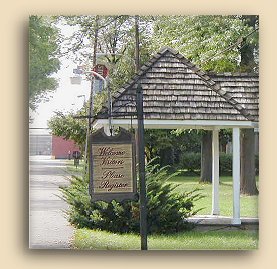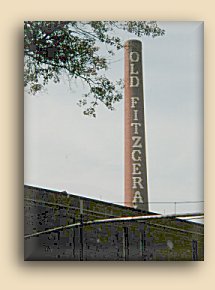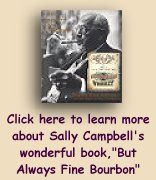American Whiskey
GHOSTS
of
WHISKIES
PAST
The
Louisville
Distilleries
Driving south on the Dixie Highway, you never even know you've left Louisville
until you start seeing the store signs. Shively Motors, The Bank of Shively,
Shively Center. The suburb of Shively, Kentucky is perhaps not as shabby
as the edges of Louisville we've just driven through, but it's been around
long enough that its post-war sparkle has faded more than a little
bit.
A sign on the left side of the road says you're passing the driveway that leads back to the very-much-alive Early Times distillery, and then you're at Ralph avenue and little more than a right turn away from one of the bourbon world's most beloved icons...
Old
Fitzgerald
~
The
Stitzel-Weller
Distillery
~
September
14,
2000
The end of World War II brought with it an end to the rationing and restrictions
that kept beverage alcohol production at a minimum.
 The
post-war prosperity and expanding popularity that bourbon saw in the Fifties
and Sixties were some of the best times the industry ever had. Optimism about
the future, and a fear of being under inventoried as they were after
prohibition fueled a fury of overproduction.
The
post-war prosperity and expanding popularity that bourbon saw in the Fifties
and Sixties were some of the best times the industry ever had. Optimism about
the future, and a fear of being under inventoried as they were after
prohibition fueled a fury of overproduction.
 Unfortunately,
by the end of the Sixties, the popularity of bourbon whiskey had begun to
level out and the Seventies and Eighties were tumultuous years in the American
whiskey business. In the summer of 1972, the Stitzel-Weller Distilling company
of Louisville, owned by the Van Winkle family and opened by its beloved
patriarch, Julian P. "Pappy" Van Winkle on Derby Day 1935, just after the
repeal of National Prohibition, was sold to Norton Simon for $20 million.
Norton Simon later sold it to Guinness of London, operating as United Distillers.
United, which owned several Scotch whisky distilleries, went shopping in
the USA the same way you might shop at a supermarket. They took a little
of this, all of that, some more of this other one, until they had accumulated
no less than seven American distilleries. In
1991 they built Bernheim, a modern, state-of-the-art facility at 17th and
Unfortunately,
by the end of the Sixties, the popularity of bourbon whiskey had begun to
level out and the Seventies and Eighties were tumultuous years in the American
whiskey business. In the summer of 1972, the Stitzel-Weller Distilling company
of Louisville, owned by the Van Winkle family and opened by its beloved
patriarch, Julian P. "Pappy" Van Winkle on Derby Day 1935, just after the
repeal of National Prohibition, was sold to Norton Simon for $20 million.
Norton Simon later sold it to Guinness of London, operating as United Distillers.
United, which owned several Scotch whisky distilleries, went shopping in
the USA the same way you might shop at a supermarket. They took a little
of this, all of that, some more of this other one, until they had accumulated
no less than seven American distilleries. In
1991 they built Bernheim, a modern, state-of-the-art facility at 17th and
 Breckenridge Streets in Louisville and closed down everything else. Even
in their new plant, they only made whiskey for about seven years before selling Bernheim to Heaven Hill in 1999 and getting out of the bourbon-making business
entirely. "Out of the bourbon-making business" isn't the same, however,
as "out of the distillery business". In the wonderful world of bourbon,
many parts of the whole process are considered legally separate, and they're
often marketed that way. The "business" is distinct from the buildings and
equipment, as are the brand (label), the formula for making the brand, the
yeast, the rights to sell (in various places), and other factors. Including,
of course, existing stock. Which is often further complicated by the fact
that distilleries usually produce several brands from different ages and
mixtures of the same stock. The way it worked with Stitzel-Weller was pretty
simple for the sale to Norton Simon and to United Distillers; the seller took the whole package.
Breckenridge Streets in Louisville and closed down everything else. Even
in their new plant, they only made whiskey for about seven years before selling Bernheim to Heaven Hill in 1999 and getting out of the bourbon-making business
entirely. "Out of the bourbon-making business" isn't the same, however,
as "out of the distillery business". In the wonderful world of bourbon,
many parts of the whole process are considered legally separate, and they're
often marketed that way. The "business" is distinct from the buildings and
equipment, as are the brand (label), the formula for making the brand, the
yeast, the rights to sell (in various places), and other factors. Including,
of course, existing stock. Which is often further complicated by the fact
that distilleries usually produce several brands from different ages and
mixtures of the same stock. The way it worked with Stitzel-Weller was pretty
simple for the sale to Norton Simon and to United Distillers; the seller took the whole package.
 The
sale of Bernheim, however was more complicated, because it was divided among
at least three or four buyers, plus the seller retained portions. Of the
Bernheim brands that had been Stitzel-Weller, Heaven Hill bought only the
Old Fitzgerald label (and probably the formula and yeast). The Old Weller
brands were sold to Buffalo Trace, where they will now be produced. Rebel
Yell went to the David Sherman Company in St. Louis, Missouri. The existing
stock of all those brands is warehoused all together at the Stitzel-Weller
facility in
Shively.
The
sale of Bernheim, however was more complicated, because it was divided among
at least three or four buyers, plus the seller retained portions. Of the
Bernheim brands that had been Stitzel-Weller, Heaven Hill bought only the
Old Fitzgerald label (and probably the formula and yeast). The Old Weller
brands were sold to Buffalo Trace, where they will now be produced. Rebel
Yell went to the David Sherman Company in St. Louis, Missouri. The existing
stock of all those brands is warehoused all together at the Stitzel-Weller
facility in
Shively.
One ironic feature of the time lag in the way that bourbon is made and aged is that many of the longer-aged brands associated with Stitzel-Weller (Old Weller Antique, Centennial, Old Fitzgerald 1849, Very Special Old Fitz 12 year old) were actually made at Stitzel-Weller. And there's still enough old stock that we'll all be drinking the nectar of that abandoned old all-copper still for years to come.
As we round a slight curve on Ralph street it's pretty obvious where the distillery is. The seven-story warehouses are easy to spot, as is the famous brick chimney with "OLD FITZGERALD" displayed upon it. We make a right turn on Fitzgerald Road (another slight give away) and soon find ourselves in front of the main gate.
When we first laid eyes on the remains of Old Crow, we had no idea what to
expect. We hadn't seen any old abandoned distilleries before, and there weren't
really a lot of photos. Seeing Stitzel-Weller
is a different matter altogether. This was a working distillery at the time
when most of the books we learned from were written. Among more recent works
is Sally Van Winkle Campbell's delightful memoir, But Always Fine
Bourbon. Pappy Van Winkle's granddaughter
 intended
to write a grown-up story about her father and grandfather, and how they
built a proud business by making a fine product the best way they possibly
could and just letting the world know it. But the book manages to go way
beyond that, presenting a little-girl's view of growing up in a time when
families were proud of what they'd taken two and three generations to build
-- whether a railroad, an automobile company, or a distillery. The book is
beautifully published, with thick covers, carefully selected and laid typography
and a variety of papers including translucent leaves. It is also blessed
with some of the most gorgeous photography imaginable, rivaling the best
of Ansel Adams' work. There is such a beauty and a life to the pictures...
intended
to write a grown-up story about her father and grandfather, and how they
built a proud business by making a fine product the best way they possibly
could and just letting the world know it. But the book manages to go way
beyond that, presenting a little-girl's view of growing up in a time when
families were proud of what they'd taken two and three generations to build
-- whether a railroad, an automobile company, or a distillery. The book is
beautifully published, with thick covers, carefully selected and laid typography
and a variety of papers including translucent leaves. It is also blessed
with some of the most gorgeous photography imaginable, rivaling the best
of Ansel Adams' work. There is such a beauty and a life to the pictures...
...And such a sadness and despair to the scene in front of us. The front door of the distillery building itself hangs open, allowing us to see into the abandoned interior. Gray paint peels from the clapboard siding in huge flakes.
There were signs and slogans here once, all over the property.
Clever ones, like this faux warning,
Nature and the old-time 'know how' of a Master Distiller get the job done here...
This is a Distillery - not a whiskey factory
"Just a taste is all we ask...
it's all we've
ever needed!".
and
At a profit if we can
At a loss if we must
But always
FINE BOURBON

 They're
still full of lots of barrels of fine, aging Stitzel-Weller and Bernheim
bourbon. A sign at the main gate suggests that trucks enter through the back
gate on Tucker Avenue. And that's where we head next, turning at the Shively
Rod and Custom Shop, where '58 Chevvies are still lowered and fitted with
lake pipes, frenched headlights, and tuck'n'roll upholstery. There is a guard
at this gate, and that's the only person we see. But trucks still move barrels
out of here, although now that Heaven Hill owns the Bernheim distillery they
probably no longer move them
in.
They're
still full of lots of barrels of fine, aging Stitzel-Weller and Bernheim
bourbon. A sign at the main gate suggests that trucks enter through the back
gate on Tucker Avenue. And that's where we head next, turning at the Shively
Rod and Custom Shop, where '58 Chevvies are still lowered and fitted with
lake pipes, frenched headlights, and tuck'n'roll upholstery. There is a guard
at this gate, and that's the only person we see. But trucks still move barrels
out of here, although now that Heaven Hill owns the Bernheim distillery they
probably no longer move them
in.



